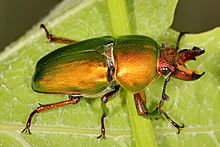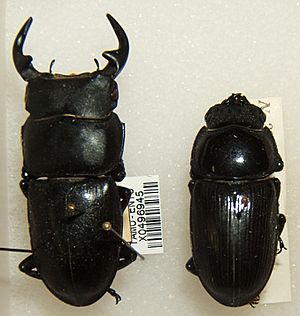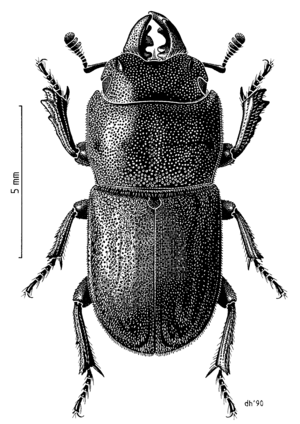Stag beetle facts for kids
Quick facts for kids Stag beetle |
|
|---|---|
 |
|
| Male Lamprima aurata | |
| Scientific classification | |
| Kingdom: | |
| Phylum: | |
| Class: | |
| Order: | |
| Suborder: | |
| Infraorder: | |
| Superfamily: | |
| Family: |
Lucanidae
Latreille, 1804
|
| Subfamilies | |
|
Aesalinae |
|
Stag beetles are a fascinating group of about 1,200 different kinds of beetles. They belong to a family called Lucanidae. Some of these beetles can grow quite big, reaching over 12 centimeters (about 5 inches) long! However, most are around 5 centimeters (2 inches) in size.
Contents
Meet the Stag Beetles
The English name "stag beetle" comes from the large, special jaws that male beetles have. These jaws look a lot like the antlers of a stag (a male deer).
One of the most famous types of stag beetle in Europe is Lucanus cervus. In some European countries, including the United Kingdom, people just call it "the" stag beetle. It's actually the biggest insect that lives on land in Europe!
Long ago, a Roman writer named Pliny the Elder wrote about these beetles. He mentioned that another writer, Nigidius, called them lucanus. This name came from a region in Italy called Lucania, where people used stag beetles as good luck charms. The scientific name Lucanus cervus combines this old name with cervus, which means "deer."
Life and Habits of Stag Beetles
Male stag beetles use their big jaws to wrestle with each other. They often fight over the best places to find a mate. This is similar to how male deer fight over females. They might also fight over food, like tree sap or rotting fruit. Even though their jaws look scary, stag beetles are usually not aggressive towards humans.
Female stag beetles are typically smaller than the males. Their jaws are also smaller. But don't let that fool you! A female's jaws are much stronger than a male's. When they are larvae (young beetles), you can tell females apart from males. Females have cream-colored, fatty parts called ovaries that you can see through their skin. These are located about two-thirds of the way down the larva's back.
The Stag Beetle Life Cycle
Stag beetle larvae spend several years eating rotting wood. As they grow, they go through three stages. The last stage is called "L3." For bigger species, like Prosopocoilus giraffa, the L3 larvae can be as big as a human finger!
After the L3 stage, the larva builds a special home called a pupal cell. It makes this cell from pieces of wood and soil. Inside this cell, the larva changes into a pupa, and then finally into an adult beetle.
In Japan, stag beetles are quite popular. People often buy them as pets, just like rhinoceros beetles.
Why Male Stag Beetles Have Different Antler Sizes
The "antlers" (jaws) of male stag beetles can be very different in size from one beetle to another. This is called a "scaling relationship" or "static allometry." It means that as the beetle grows, its jaws grow in a specific way compared to the rest of its body.
The conditions where a young beetle grows up, like how much food it gets, can affect how big its jaws become. However, the size of the jaws is also partly controlled by the beetle's genes.
See also
In Spanish: Lucánidos para niños




